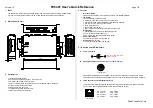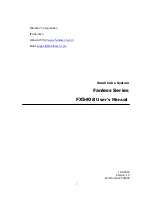
Oil Seal Replacement
•
Falk Horizontal Shaft Backstops
(Page 2 of 3)
Type NRT • Sizes 70-180, 1070-1185, Model E
568-131
Rexnord, 3001 W. Canal St., Milwaukee, WI 53208-4200, USA
October 2014
Telephone: 414-342-3131 Fax: 414-937-4359
NEW www.rexnord.com
BACKSTOP SEAL REPLACEMENT
Removal
CAUTION:
Remove all external loads from drive before
servicing drive or accessories. Do not damage cam hub
face: new seals will leak if seal contacting surface is
marred. Do not use abrasive material on seal contacting
surface.
1. To prevent dirt from falling into the backstop,
thoroughly clean the exterior of backstop with clean
non-flammable solvent.
2. Remove labyrinth cover (See Figure 4) from backstop.
Clean cam and hub face with solvent and remove all
sharp edges.
3.
Outer Seal
—
With a hook shaped tool reach over
the outer seal and pull outward moving around the
opening, (see Figure 2).
4.
Inner Seal —
Use a sharp center punch to lightly
punch the seal case as a guide for the drill.
5. Wrap several turns of tape around the drill
approximately .250” (6mm) from the drill point to
prevent the drill from entering too deeply into the
housing and damaging the bearing (inner seal only).
Grease or magnetize the drill to help retain the chips.
Drill two .125” (3mm) diameter holes in the seal case
180° apart. Control the angle of the drill as illustrated
in Figure 6 to prevent damage to the cam.
6. Insert two #10 sheet metal screws of sufficient length
into the seal. DO NOT drive the screw more than .250”
(6mm) beyond seal face or bearing damage may
occur. Use a claw type pry bar under the screw head
as shown in Figure 6, and pry the seal out. Remove
all chips. Use a magnet to remove the chips that fall
into the bore. Remove Permatex sealant from housing
bore. Inspect the seal cavity and remove any debris
or metal chips. Thoroughly clean the seal cavity with
clean non-flammable solvent.
Installation
1. Check seal surface for any damage prior to installing
new seals. Install one seal at a time. Coat the outside
diameter of the inner seal housing bore with Permatex
#3 or equivalent sealant.
5.
Outer Seal —
Apply a thin layer of NLGI#2 grease to
the outward face of the inner seal. Position the new
outer seal on the inner cam with the lip facing inward
(See Figure 4). Stretch the seal around the inner cam
moving around the diameter evenly until the outer seal
is installed to the depth as found in Table 1.
6. Check seal runout with a depth micrometer, dial
indicator or bar micrometer as shown in Figure 3.
Runout must not exceed .010” (0.25mm) TIR.
7. Replace the labyrinth cover and screws. Ensure the
gap between the inner cam and labyrinth cover is
even all the way around. (See Figure 7.) Torque the
bolts to 14-17 lb-ft (18-23 Nm).
INNER SEAL RUNOUT
REFERENCE SURFACES
MEASURE PROPER
DEPTH USING DESIRED
MEASURING METHOD AS NOTED
Figure 3
Figure 4
OUTER SEAL
INSTALLATION DEPTH
LABYRINTH
COVER
2.
Inner Seal —
Position the inner seal squarely in the end
cover with the garter spring positioned per Figure 7.
3. Place a square ended cylindrical tool against the seal
and press or lightly tap the tool (not the seal) until the
seal is seated against the shoulder. (Figure 3)
4. Check inner seal backface runout with a depth
micrometer, dial indicator, or bar micrometer as
shown in Figure 3, must be performed prior to outer
seal installation. Runout must not exceed
.010” (0.25mm) TIR.
Figure 2





















